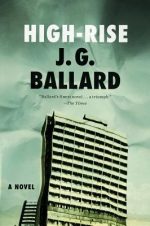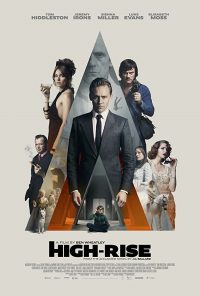The film adaptation of J.G. Ballard’s classic satire loses the plot, literally.
I have been slogging through one hell of a blogging slump. So I was lucky that a recent family outing to The Incredibles 2 inspired me with its retro-futurist look, a vision of modernity that takes its cues from 1950s sci-fi. It brought to mind another retro-futurist movie I caught up with recently: High-Rise, Ben Wheatley’s 2015 film based on the J.G. Ballard novel of the same name.
Pixar’s animated movie uses a joyful, colourful palette to set the tone for it’s superhero adventure. Meanwhile, High-Rise‘s vision of the future originates from the 1970s, when the book was written. It utilizes the concrete slabs of brutalist architecture to express its themes.
The reason I’m fixating on the look of High-Rise is because there’s not much substance to it. Most of the book’s story elements and pointed commentary on classism and capitalism have been stripped away. It’s left a film that’s a delightful sensory experience, but not much else.
The Story:
 On its surface, the movie hews closely to the original 1975 novel
On its surface, the movie hews closely to the original 1975 novel. In J.G. Ballard’s story, a new, high-tech high-rise apartment opens in London’s East End. The first of several planned towers, it’s a self-contained society, with its own shopping centre, school and recreation facilities. The new residents, despite being all white and middle-class, soon find reasons to divide into new social strata. These factions rapidly descend into open warfare, literally fighting over groceries, parking spaces and time in the swimming pool. As their insular society grows ever more barbaric, life outside the apartment continues with an facade of normalcy.
Differences between the two:
 The novel made clear the inner desires of the main characters, however disturbed they were. It’s difficult to discern what the movie’s characters are after.
The novel made clear the inner desires of the main characters, however disturbed they were. It’s difficult to discern what the movie’s characters are after.- In the novel, the protagonist, Dr. Laing, has a sister who lives in the same building. In the movie, he has no living family.
- One character’s literal social climb through the building, a major sub-plot of the novel, is missing from the movie.
Whereas the wicked satire of the book made me smile, my reaction to the movie was a big long “Whaaaaaaaaaaa?”
What the book does well:
- The tone of the satire is pitch-perfect, as reflected by the classic opening:
Later, as he sat on his balcony eating the dog, Dr. Robert Laing reflected on the unusual events that had taken place within the huge apartment building during the previous three months. Now that everything had returned to normal….
- The repetitive cycle of divisions along class lines, no matter how small the group, was a stark statement on human nature under capitalism.
What the movie does well:
- It absolutely nails the look and feel of a high-rise apartment of tomorrow, circa 1975.
- The disjointed construction of the film itself parallels the anarchy depicted onscreen.
- The transformation of the characters into animalistic, primal beings is well dramatized.
Ultimately, the movie was a disappointment for me. I got a real kick out of the visual depiction of what I’d read on the page. But without the biting commentary at the heart of the novel, it felt a bit empty. The movie adaptation is aggressively weird. After ignoring the social commentary for so long, a Margaret Thatcher soundbite tacked on at the very end feels out of place.
While that lack of message and structure might be the film’ making its own statement, I couldn’t really recommend it to readers who loved the novel. Still, it is beautiful to look at.